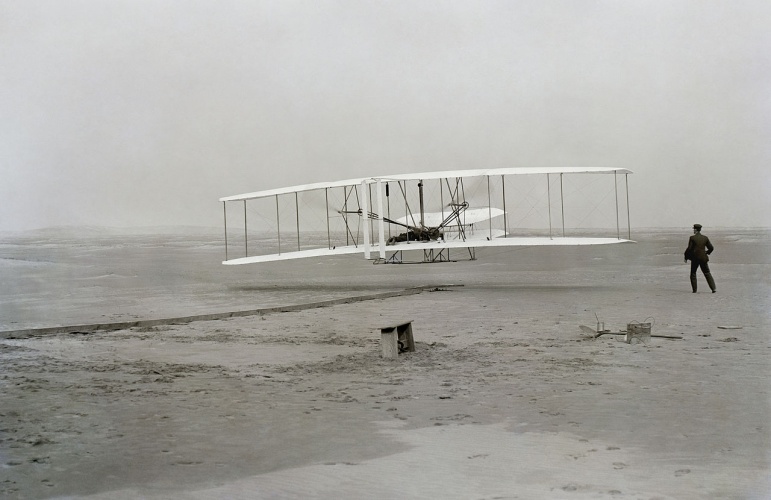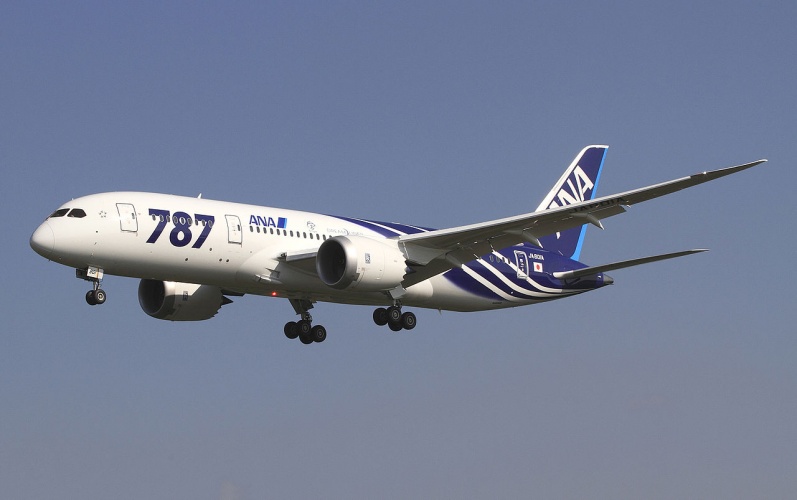The aircraft wing has transformed from the wooden and fabric twin-wing set up of the Wright brothers’ Flyer, to the composite materials used in the latest models coming off the production line today from the likes of Boeing and Airbus. In fact, Orville Wright’s first flight, lasting 12 seconds, travelled 120ft - less than the wing span of a Boeing 747. The basic forces acting on an aircraft are thrust, drag, lift and weight. OEMs are today placing a major focus on trying to reduce drag and weight across all components, in an effort to improve performance and efficiency.

(Credit: John T Daniels)
While the basic aerofoil shapes laid out in the 1930s by NASA (and its predecessor NACA) have remained, the fundamental platform for generating the lift component, there have been huge advances in both the materials and manufacturing processes used.
Efficiency is at the front of airline executives’ minds. As an increasingly demanding customer base calls for cheaper flights, cost effectiveness in both the operation and manufacturing of the aircraft is crucial for airlines to maintain profit margins. As airlines constantly push their manufacturing suppliers to deliver more efficient aircraft, OEMs are turning to technology to drive improvements in wing design and manufacture, focusing on improvements in aerodynamics and reductions in component weight.
Lightening the load to reduce fuel burn
Fuel efficiencies are a major part of potential cost savings for operators. The amount of fuel used during a flight is approximately proportional to the drag of the aircraft. Higher drag on the aircraft means more fuel burnt and more cost to the operator, so designers and manufacturers throughout the supply chain have focused on reducing this in wing design. The two key factors here are weight and aerodynamics. Better aerodynamics reduces the force and fuel required to move the plane through the air and lightening the load decreases the lifting force required.
The introduction of advanced composite materials has reduced the weight of aircraft wings, in comparison to the predominantly aluminium structures that have dominated the industry since the 1960s. Also, because they are composites, there is a secondary benefit in the ability to “tailor” them to specific design loads, strengths and tensions for different wing and aircraft models. In recent years, this process has been further improved through the addition of nanomaterials that are applied to composites during manufacturing. The size of these materials means that they can be used to make the composites even more specific to job functions in the wing. For example, incorporating electrical conductive nanoparticles into structural components that can guard against lightning strikes, or high-strength nanoparticles that can improve the damage resistance of the outer wing laminate.

Boeing's 787 Dreamliner uses composite materials to reduce weight (Credit: ANA)
Another major technological advancement is the application of rapid prototyping, facilitated by 3D printing. With the development of advanced computing, analysis and design techniques, that very quickly assess the effectiveness of the prototypes, this process is being used to achieve significant weight and aerodynamic savings. It allows new and innovative design ideas to be trialled, adapted and perfected at minimal cost, before graduating to wider production. Crucially, these developments are aimed at manufacturing lighter wing components, that construct a more aerodynamic wing structure, at lower production costs. These innovations are driving fuel and costs savings that can be passed on to the airline operator.
Incorporating innovations into wing structure
Technology is also having a secondary impact on the design and construction of aircraft wings, as they increasingly have to support and house new hardware used for structural health monitoring. This advanced technology is being incorporated into the finely tuned wing structure design and production, with sensors that monitor key performance parameters during flight. Additional allowances have to be made for the physical space they need and the added weight these sensors bring. The latter is an area where there is still significant potential improvement to be made. Again, OEMs are exploiting new manufacturing methods, such as 3D printing and rapid prototyping, to solve this issue, shaping and refining the product to optimise dimensions and incorporate the new technology without compromising the highly tuned wing structure.

Sharklets on an Airbus A320 (Credit: Simone Previdi)
Recent years have also seen the advent of design innovations at the wingtips that have significantly improved aerodynamic performance of aircraft. Sharklets (Airbus) or raked wingtips (Boeing) reduce the effects of the “wake” – the swirling vortex of air left behind the wing as it passes through the air at high speed. These usually take the form of small upward-pointing extensions at the tip of the wings. By reducing the disturbance made to the air, the passage of the aircraft is smoother and more efficient. It achieves the same effect of massively increasing the wingspan of the aircraft, but without the added weight. Applied to new aircraft design and even retrofitted to old models, these alterations at the wingtip have realised dramatic drag and fuel efficiencies. Boeing, for example, has shown that, when applied to the 767 aircraft, it realised a 4-5 per cent fuel burn improvement, which translates to 500,000 US gallons of jet fuel and 4,790 tonnes of CO2 per plane per year.
The aircraft wing has undergone a transformation since the Wright Brothers’ first flight. Most excitingly, OEMs are taking advantage of new technologies and design methodologies to drive improvements in aerodynamic performance and reduce the weight of components throughout the wing structure, and airlines are realising huge fuel efficiency savings as a result.





Nanogenerator consumes CO2 to generate electricity
Whoopee, they've solved how to keep a light on but not a lot else.